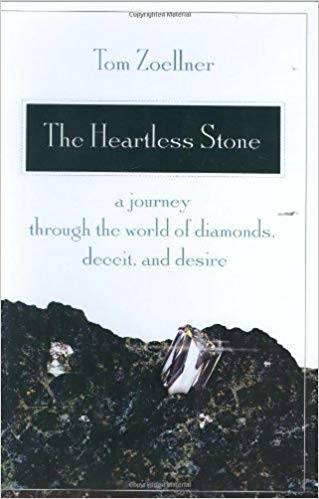
The critically acclaimed investigation into the global diamond trade
The Heartless Stone unmasks the fascinating history behind America’s favorite gemstone. Tom Zoellner takes you on an unforgettable journey through six continents — from the deadly mines and smuggling rings of Africa to mining camps above the Arctic Circle to India’s polishing mills where teenage children cut stones that eventually find their way to the shopping malls of America.
How did this relatively common mineral come to signify love and eternal promises? Why are diamonds so unnaturally expensive — yet so coveted? Why do so many risk their lives and integrity to acquire them? The answers will surprise, intrigue and disturb you, as Zoellner looks into his own powerful fascination with the diamond ring left behind from his broken engagement. The Heartless Stone goes beyond investigative reporting and explores the complicated regions of the human heart that make the diamond empire possible.
Praise for The Heartless Stone:
“A dazzling display of intrepid reporting.”
—Entertainment Weekly
“An illuminating expose of a mineral and an industry.”
—Wall Street Journal
“An exhaustively researched and beautifully written work of narrative nonfiction.”
—The Atlanta Journal-Constitution
“The author is expert with vivid prose…This is a superior piece of reportage.”
—Publishers Weekly (Starred review)
“Lives up in every way to the power of its almost magical subject….With on-the-spot reporting from each of these locales and detailed portraits of individuals whose lives have been shaped by the quest for and business of diamonds, Zoellner follows a tortured trail all the way to the ring finger of an expectant bride. En route, he offers fascinating details about the geology, craftsmanship, advertising, economics and politics surrounding the gem.”
—Kirkus (Starred review)
“A thoroughly engrossing and admirable piece of journalism. Part investigative reporting, part ‘extreme’ travelogue, it reveals through vivid details of geology, artistry, marketing, economics and politics, how diamond lust has changed cultures and societies forever.”
—Albuquerque Journal
The octahedrons looked melted and yellowish, as if a drunken craftsman had glued two small pyramids together and then put it to a blowtorch. This is the way they look when you first find them in a mine: milky and warped, but retaining a crystalline shape, as if some living thing at the center had carelessly reproduced itself by the trillions.
He set them in a line on the patio table. His three friends studied me as I held one of the stones up to the sunlight and tried to peer into it.
We’re going to have to make this quick, said the man who owned the house. The police could come in, and then we’d all be in jail. He smiled vaguely at this thought. Across the alley, birds roosted in the broken-out window frames of a government building.
The smuggler watched me peer into the rock. He said something in French to his friends. One of them tapped out a quick rhythm in his hand with the butt of his cell phone. Another glanced at the door to the alley and fingered the edge of the jacket he wore, even though it was a warm day.
You brought these from the Congo? I asked.
Today, he said. In a wooden canoe rowed over to Bangui. The mine itself was several hundred kilometers away, down a road into the jungle. I looked again at the dull yellow shape, wondering about its history, pretending I knew what I was looking at.
He is wondering who you really are, said the man who owned the house.
The smuggler placed the stones in the middle of a bank note, carefully folded it into a square and made it disappear into his pants pocket. All four of them stared at me with flat eyes.
There are more where these came from? I asked.
Oh yes, I was told. Hundreds more. Thousands more.
Now: did I want to buy?
* *
No. I have bought only one in my life. It was three years ago in California, over an ammonia-washed glass countertop. I was planning to ask my girlfriend, Anne, to marry me and was full of new love. Jacqueline, the Asian woman behind the counter, showed me a series of stones, which she poured out of individual manila envelopes and set in a line. I peered at them all under a jeweler’s loupe, as if I knew what I was looking at, and listened as Jacqueline explained the relative merits of each. She showed me the tiny angular hearts that clustered around the bases, like the petals of a flower. You couldn’t see them without the loupe.
There was one a bit clearer than the rest, slightly over a carat, and we haggled over the price a bit before I decided to buy it. Jacqueline fitted it into a Tiffany setting and I picked it up a week later. The stone was held aloft over the band in gold supports, like a preacher in his pulpit. I admired its sparkle. Jacqueline called it “the firing.” I was then two weeks away from giving the ring to Anne on a precipice of land that overlooked the Golden Gate Bridge through a tunnel of cypress. This was to be a moment I had dreamed of since I was old enough to understand there was something special about girls.
“Where did it come from?” I asked her, just to say something. I was privately marveling at writing the biggest check of my life.
“I don’t know,” she said.
“Is there any way to tell?” I asked.
“Not really,” she said. “Probably Africa. That’s where they all come from.”
* *
The place to go if you want to see how diamonds really make their way to America is a place called the Central African Republic. It is a landlocked crescent of ochre-colored earth about the size of Texas at the geographic heart of Africa. To fly over it at night is to fly over a carpet of complete darkness except for the occasional small cooking fire flickering up through the trees. There are no traffic signals, not a single mile of railroad track, and almost no electric lights outside of the capital city of Bangui. The nation is so poor that the government cannot pay its own employees any wages, and uniformed soldiers routinely beg money from passersby, rubbing their camouflage-covered stomachs to convey hunger. Butterflies alight on the dirt roads and broad jungle leaves, and some locals try to make money by ripping the colorful wings off the butterflies and gluing them to paper to make artwork.
Children drunk on glue wander the filthy core of Bangui in broken flip-flops, begging for francs. Their T-shirts from Western aid agencies are often dotted with gummy clots; this is where they have smeared the glue to huff through the cloth. Shoe polish is another favorite intoxicant – it is spread on bread like jelly and eaten for a high. Still others take a stolen audiotape and soak it in a jar of water for a week. The resulting home-brew brings strange hallucinations. Some of the street children will grab their crotches when they approach new faces for coins. Trading sex for money is common here, despite a national rate of AIDS infection estimated at one in every seven persons. “It’s not always for money,” a French schoolteacher told me. “Children need affection, to be touched is instinctual, and this is the only way a lot of them can get it.”
The borders have been sealed to foreigners ever since the latest in a long series of coups toppled the government in March 2003, so there is really only one legitimate way in or out. That’s the once-weekly Air France flight from Paris, which is inevitably crowded with a slice of the nation’s tiny ruling class — the only ones who can afford the fare. The Sunday morning arrival of Air France is a free-for-all holiday for the northern part of the city of Bangui. Hundreds of taxi hustlers and freelance luggage porters cram close to the perimeter fence as they watch the passengers step from one world into another, out of the air-conditioned cabin with its fois gras and Bordeaux and copies of Paris Match and into the fecund obscurity.
In a waiting room nearby, with thick wire mesh and tattered curtains covering the windows, are the departing passengers. They were protected like dignitaries from the grabbing masses outside. I learned later that some of them were almost certainly carrying a highly portable fortune in the folds of their business suits and warm-up jackets. They were able to carry wealth that equaled the year’s wages of more than 2,000 men. And without showing a bulge.
This is because the Central African Republic — corrupt, destitute and nearly forgotten by the rest of the world — is one of the best places on the continent to make a dirty diamond look clean.
I came because I wanted to see how it was done.
A: It’s now a $25 billion dollar business. Seven out of every ten American women own at least one. But as it turns out, the idea of a diamond as a popular luxury item is fairly new in this country. A magazine advertising campaign sponsored by De Beers created the consumer desire just a few years before World War II. They sought to make diamonds not just rare, but essential for every man seeking to get married. Famous painters such as Pablo Picasso and Salvador Dali were commissioned to create landscapes next to advertising text that had a strange fixation on death, of all things. But De Beers tried to plant this subtle idea that diamonds are a kind of shield against mortality. “Diamonds are the most imperishable record a man may leave of his personal life,” said one of the ads. That’s part of the source for the famous slogan they eventually cooked up in 1948: “A Diamond Is Forever.” A phony “tradition” was also established: a groom must spend two months’ salary on his wife’s stone. But this was not a global standard. British men were viewed as more stingy and were told to save one month’s pay. The Japanese, seen as more obedient, were told three.
Q: Who is De Beers and what does your book say about them?
A: De Beers Consolidated Mines, based in Johannesburg, South Africa, has dominated the industry for more than a century. It was founded by the imperialist Cecil Rhodes, who managed to corner almost all of the mining claims in South Africa in the 1870s and thus make diamonds “rare” when they’re really not. If there was ever a truly free market in diamonds, these stones would cost a fraction of their current price, so no free market could be allowed to exist. This philosophy has kept jewelry prices sky-high ever since. Despite new discoveries in Canada and Australia, De Beers still has enormous amount of control over the diamond trade. DeBeers influences every diamond purchased in the world in some way or another, and yet so little is known about them and how they do business. This book is really the first to explore the history and inner workings of the organization in a complete fashion.
Q: What inspired this book?
A: A lot of it was because of the weird relationship I had with the diamond ring left over from a broken engagement. I was pretty depressed and found myself dealing with the heartbreak in an odd sort of way. I became slightly obsessed with the ring my ex-fiancée gave back to me. The thought of selling it was too hard to contemplate. But at the same time, I knew it was only a polished piece of carbon and I had never been very interested in jewelry before. So why did I care so much about this ring? Finding the answer to that question took me around the globe.
Q: The reporting took you to six continents. What did you find?
A: I met some people I will never forget. Many of them were working in the most obscure places you could imagine – dingy factories in India, distant hilltops in Brazil, villages in Central Africa, warehouses in Siberia, mining camps above the Arctic Circle. The stories I heard were incredible. Diamonds have made fortunes and ruined lives in places you wouldn’t expect.
Q: Were there some dangerous moments?
A: There were a few occasions when I was mistaken for a diamond smuggler. I was arrested and briefly detained in a central African country for reasons that were unclear to me at the time. I got feverish and sick from bad water. But other than that, it went pretty smoothly.
Q: What are “blood diamonds”?
A: These are diamonds that are mined in violent places and used to buy guns and landmines. Children are also forced to pick up shovels and dig for stones that eventually will become a part of somebody’s wedding ring in America. At one point not so long ago, nearly one in six of the diamonds sold in this country had probably come from such circumstances. The problem is, it’s impossible to know. De Beers and the rest of the diamond industry have taken steps toward correcting the “blood diamond” problem, but the solution they devised, known as the Kimberly Process, is full of flaws and loopholes. And so diamonds with violent pedigrees are still being sold as “symbols of love” in America, and the consumer has no way to know about it. One of the biggest problems is that it takes a formal state of war to trigger a sanction against a diamond-producing nation. But several regions in Africa are permanently unstable, with people being robbed, beaten and killed around the mines every day. The workers often have to swallow the bigger diamonds to smuggle them out, and people are sometimes sliced open like fish so their intestines can be searched for hidden stones. Those are very bloody diamonds, but so far as the industry is concerned, they’re pure as a snowflake. They’re under the glass right now at your local shopping mall. future projects?
Q: If diamonds can be so unsavory, why do people continue to buy them?
A: There’s an old saying in the business: “If diamonds didn’t exist, we would have to invent them.” This book goes deeply into the psychology behind the desire to wear a brightly colored stone. I think it goes straight to the heart of the experience of being alive—this urge to possess and coexist with a sliver of perfect beauty. De Beers and the rest of the industry have built a brilliant mythology around this simple urge. And so there’s this collective myth about diamonds in American society, in Japanese society, in European society, in just about every place that diamonds have been marketed. The ironic thing is that diamonds are fundamentally worthless. They’re just rocks that twinkle under the light. I mean, big deal, right? They are valuable only because we’ve been taught to project our own longings onto them. That’s the REALLY interesting thing about diamonds: the way they become these little sparkling holding devices for our own primitive emotions and hungers. I experienced this myself in a very personal way when I found myself mythologizing my ex-fiancée’s diamond as some kind of symbol of what the relationship had been and would never be again. And I’m a slobby, beer-drinking guy who had never cared about jewelry before.
Q: After all that you’ve experienced, do you think you’ll ever be able to purchase a diamond again?
A: I understand the appeal. I bought one for someone once. But I’ll never buy another one again.

Tom Zoellner is the New York Times bestselling author of nine nonfiction books, including Uranium Train and The Heartless Stone. He teaches at Chapman University and Dartmouth College. A former reporter for the San Francisco Chronicle, he is the editor-at-large at the Los Angeles Review of Books.



